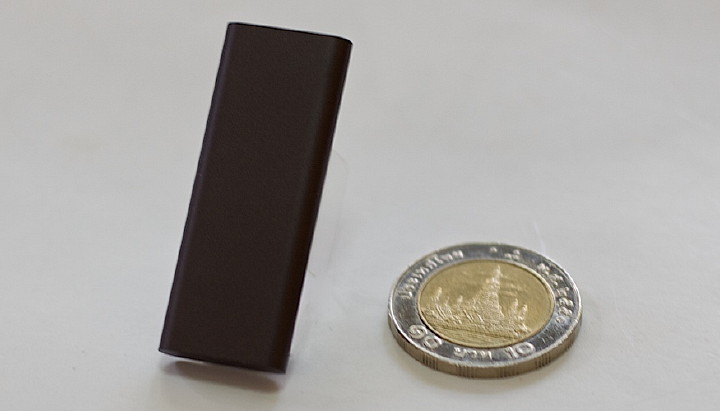
My favourite iPod is the iPod touch, but before that arrived I preferred the iPod shuffle. The first was a thin white stick that looked like a pack of chewing gum of 512MB; the second a squat rectangle with twice that capacity. Both had Apple's click-wheel, but with random selection I let the iPod surprise me.
The iPod nano that arrived recently, used technology that announced information to users. Some had already been available using the Nike+ system, which was useful for those taking part in sports, but this increased the user experience. It was also valuable for enabling blind people to navigate the menus in the same way as Universal Preferences may be used on the Mac.
Apple has now updated the iPod shuffle. It is a little taller with a square cross-section. The click wheel has gone and controls are on the cable to the right earbud. The new shuffle has four times the capacity of the previous version at 4G, which Apple claims can carry 1,000 songs. The price has increased slightly to 3,290 baht here (from 2,290 baht). With the greater capacity, we can now add playlists from iTunes, but those songs and playlists need some help to navigate. Apple has developed a "VoiceOver" facility that announces what is being played and is used to navigate the tunes.
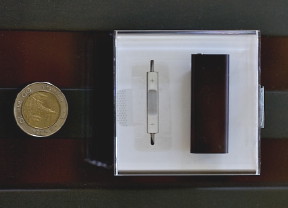 The shuffle, in black or silver, comes with the headphones and the USB adapter. This is a short cable with the connector at one end. The other end slots inside the speaker port, a neat piece of engineering from the previous shuffle which used a dock (the first version had USB within the body construction). With the shuffle attached to my MacBookPro, I found it easy to come into contact with it while working and this may disturb the connection. An extension cord might be useful here to keep it out of the way.
The shuffle, in black or silver, comes with the headphones and the USB adapter. This is a short cable with the connector at one end. The other end slots inside the speaker port, a neat piece of engineering from the previous shuffle which used a dock (the first version had USB within the body construction). With the shuffle attached to my MacBookPro, I found it easy to come into contact with it while working and this may disturb the connection. An extension cord might be useful here to keep it out of the way.
When it is first connected, the iTunes welcome screen appears offering registration and the setting up of an iTunes account. A panel also appeared showing an update to the VoiceOver software (now updated to version 1.0.1) which I did install later: after the music was added. This was a mistake. It needs to go on first. As I had a full iPod, I had to restore and start again. This was not a hard task. VoiceOver provides voices for 14 languages, although Thai is not included.
If no playlists are checked, the software creates an "iPod selection" for the shuffle. Users can create these playlists for the individual device. I have three iPods and each has its own specific settings.
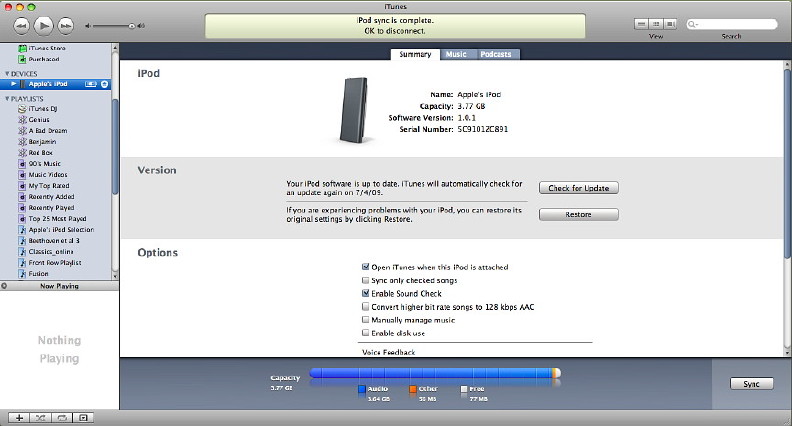
Apple advertises the shuffle as holding 1,000 songs. These are with specific parameters: 4 minutes per song and 128-Kbps AAC encoding. With the tunes in my music collection including lengthy symphonies and operas, as well as hip-hop and punk (we have eclectic tastes), all encoded in MP3 format, the 623 tunes installed was a fair compromise.
A better way to look at this is time: after changing the selections, I ended up with 624 tunes indicating 2.4 days: more than enough for shopping in Bangkok.
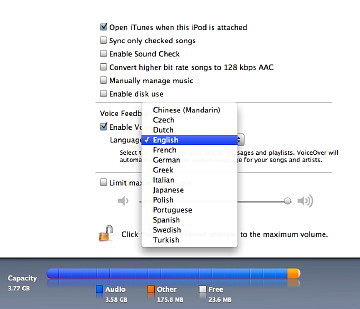 Sound files for the system, are installed in the iPod and are shown as property list files although they are not normally accessible. I found when poking around that all the system sounds files are in .WAV format. Apple declined to comment on this, so I guess that it may be to enhance compatibility for those using PCs. For the user of OS X Leopard, the voice used is Alex. For those with earlier versions of OS X or PCs a different voice is used.
Sound files for the system, are installed in the iPod and are shown as property list files although they are not normally accessible. I found when poking around that all the system sounds files are in .WAV format. Apple declined to comment on this, so I guess that it may be to enhance compatibility for those using PCs. For the user of OS X Leopard, the voice used is Alex. For those with earlier versions of OS X or PCs a different voice is used.
The controls are on a small clicker on the wire to the right earbud. With its proximity to the ear, although it can be seen out of the side of the eye, focussing is impossible, so control is by memory. Fortunately there are only a few basic commands. Top and bottom of the control are plus (+) and minus (-) signs for volume increase and decrease. The dip between these two has four modes: one click, two clicks, three clicks and hold which activates announcements of the artist and song, and then the playlists.
The shuffle itself has a single three-position switch for Off, Sequential playing and shuffle of music. Icons on the rear, close to the top show these positions. The switch is beside the headphone port, which also doubles as the connector for charging and synchronisation.
The headphone jack and connector have four metal contacts, while normal iPhone headphones, which cannot control this shuffle, have three contacts. I am not sure if these earbuds have better response, or if it was just that the design made them a better fit, but I found that the sound had far more detail and I am already pleased with the way iPods produce more of the sound information.
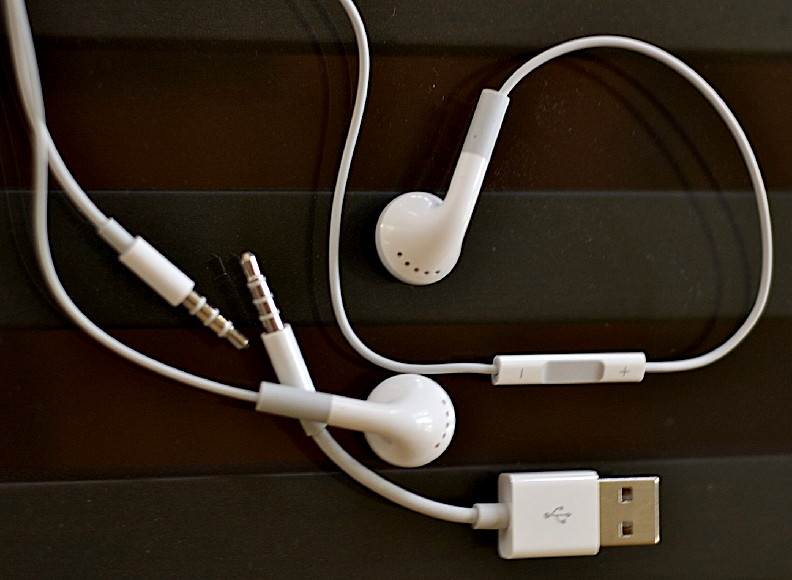
|




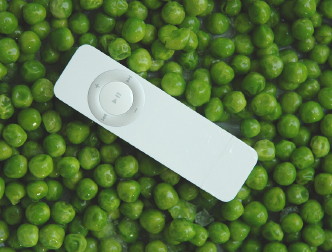
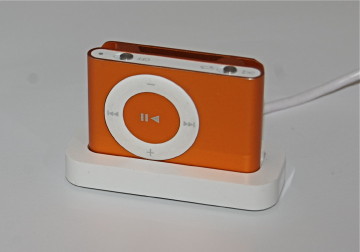
 The shuffle, in black or silver, comes with the headphones and the USB adapter. This is a short cable with the connector at one end. The other end slots inside the speaker port, a neat piece of engineering from the previous shuffle which used a dock (the first version had USB within the body construction). With the shuffle attached to my MacBookPro, I found it easy to come into contact with it while working and this may disturb the connection. An extension cord might be useful here to keep it out of the way.
The shuffle, in black or silver, comes with the headphones and the USB adapter. This is a short cable with the connector at one end. The other end slots inside the speaker port, a neat piece of engineering from the previous shuffle which used a dock (the first version had USB within the body construction). With the shuffle attached to my MacBookPro, I found it easy to come into contact with it while working and this may disturb the connection. An extension cord might be useful here to keep it out of the way. Sound files for the system, are installed in the iPod and are shown as property list files although they are not normally accessible. I found when poking around that all the system sounds files are in .WAV format. Apple declined to comment on this, so I guess that it may be to enhance compatibility for those using PCs. For the user of OS X Leopard, the voice used is Alex. For those with earlier versions of OS X or PCs a different voice is used.
Sound files for the system, are installed in the iPod and are shown as property list files although they are not normally accessible. I found when poking around that all the system sounds files are in .WAV format. Apple declined to comment on this, so I guess that it may be to enhance compatibility for those using PCs. For the user of OS X Leopard, the voice used is Alex. For those with earlier versions of OS X or PCs a different voice is used.